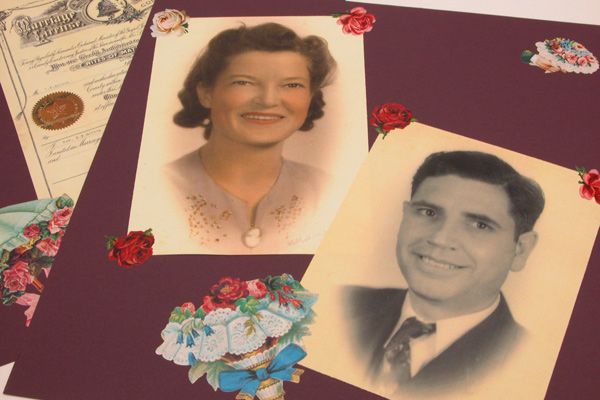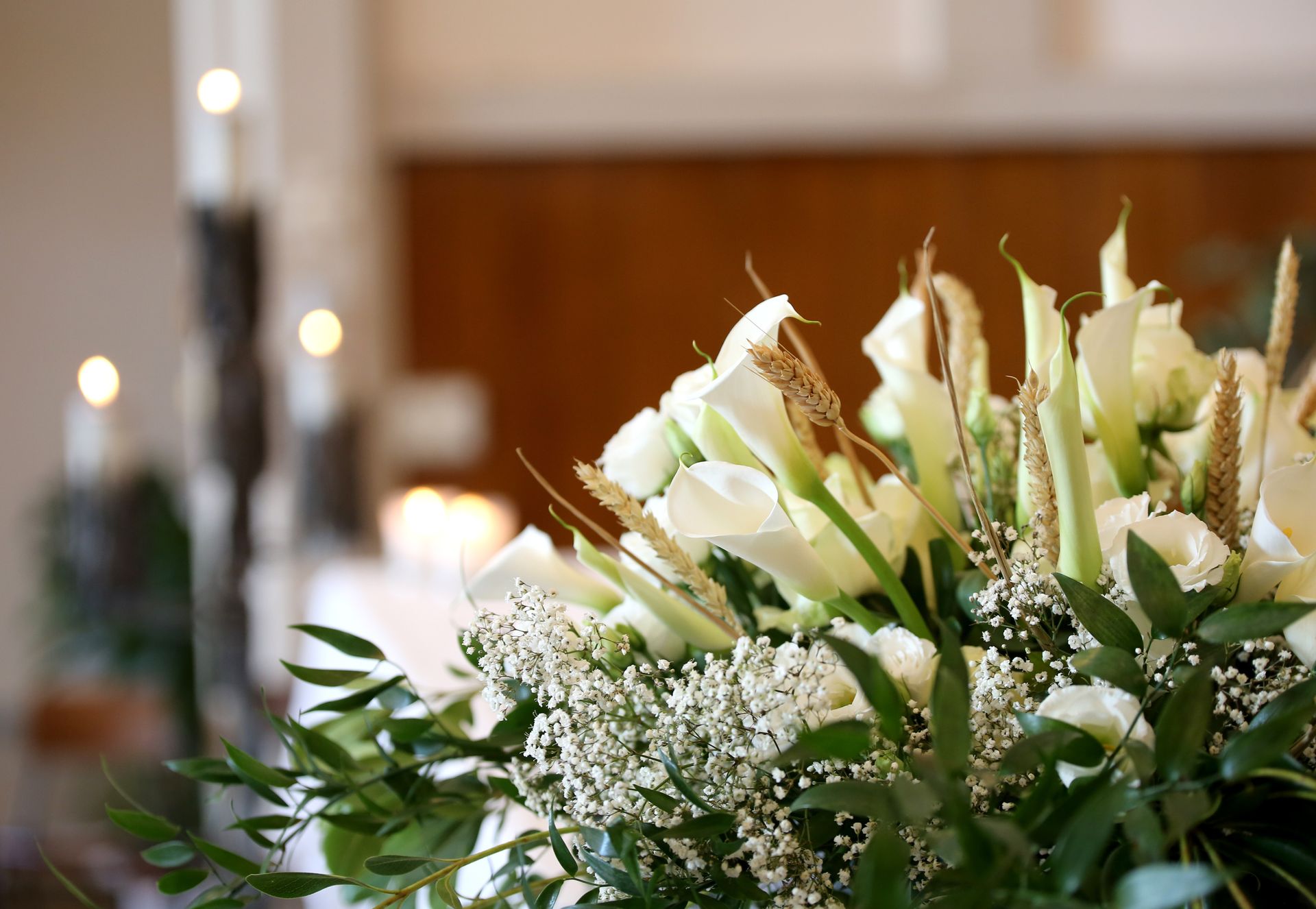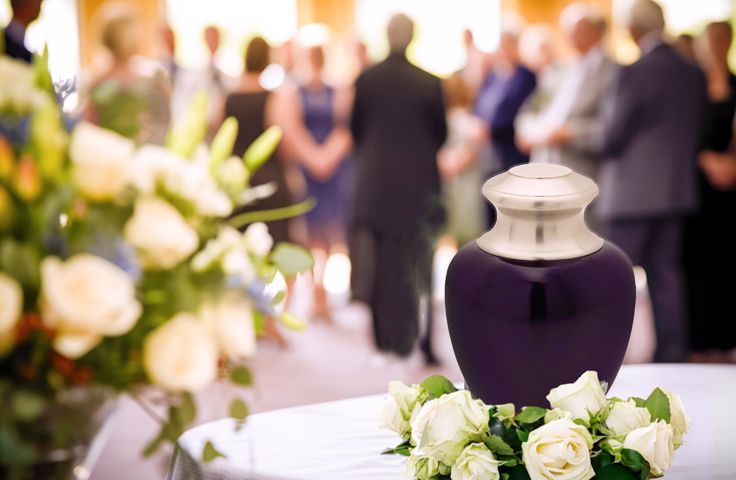Creating a beautiful ceremony for your loved one

A traditional funeral ceremony tends to be a structured, formal event. If you prefer a more informal type of gathering, there are many ways to make a funeral for your loved one unique and memorable, just like their life. Here are just a few ideas.
- Hold the gathering at a place that was special to them or that they would have liked.
- Print a large photo of your loved one to serve as a focal point during the gathering.
- Set out a guest book for guests to read and sign. This can be a simple guest register, or something even more creative. If you like to scrapbook and have the time, create a memorial scrapbook and lay the pages out individually across a few tables. Guests can sign and write a memory next to a favorite photo. When you reassemble the pages later, you will have a beautiful memory book.
- Create a memorial video with a slideshow of photos to play during the event. Time spent gathering photos and sharing memories can be a healing experience for you and your family. Our staff can put the video together for you.
- Set up a memorial table with mementos such as cherished possessions, awards, photographs, artwork, other creations. If your loved one was an artist, hang their artwork or decorate the funeral chapel with art that illustrates their personality or interests. Was the deceased a quilter? Display some of their best work. Was she a particular fan of Picasso? Why not find some prints to display?
- Set up a digital photo frame to show even more photos.
- Select a customized casket or urn. These days, urns and caskets come in a variety of materials, and they can often be customized. When picking out a casket or urn, think of how you can choose one that reflects your loved one’s personality or interests. Caskets come in materials such as metal, standard steel and wood. Hardware on the casket, such as custom handles and corners, can reflect objects that the deceased admired. Some examples are flags, favorite sporting team, praying hands and flowers. With both caskets and urns, you can often choose custom engravings or other personalized elements, so don’t be afraid to discuss your options with our staff.
- Ask guests to write memories on note cards as they arrive, or in the days before the service, to be read aloud.
- Don’t be afraid to show and invoke emotion. A meaningful funeral will have both tears and laughter as you mourn, but also celebrate together.
- If the obituary is not provided in written format, consider reading it during the gathering before a time of sharing.
- Use readings, eulogies and music to paint a picture of what they saw and experienced throughout their lifetime, including historical, civic and personal events. Explain to younger guests what life was like for them growing up.
- Tell their favorite stories or jokes. Have a storytelling contest among the guests for the best story about their life.
- Play their favorite music in the background of the gathering, or arrange for local musicians to play covers of their favorite songs.
- Collect memorial donations for their favorite charity or organization.
- Make copies of favorite photos of your loved one, and paperclip them to helium-filled balloons. Guests can take a balloon, keep the photo as a memento, and release the balloons together outdoors.
A funeral or memorial gathering can be as unique as your loved one.

Attending a funeral or memorial service can stir up many emotions, and for some, one of the first questions that comes to mind is: What should I wear? While traditions around funeral attire have evolved, dressing appropriately remains a way to show respect—for the person who has passed and for their loved ones. Whether the service is formal, casual, religious, or a celebration of life, here are a few thoughtful guidelines to help you choose what to wear. 1. Stick to Neutral, Conservative Colors Black is the traditional color of mourning in many cultures, but it's not your only option. Other respectful colors include navy, gray, deep green, brown, and muted tones. Avoid bright colors, loud patterns, or anything that draws unnecessary attention unless the family has requested otherwise. Tip: Some services may invite guests to wear the deceased’s favorite color or dress casually—check the obituary or invitation for guidance. 2. Dress Modestly and Neatly Funeral services are somber occasions, so choose clothing that is clean, pressed, and conservative: For women, options include a modest dress, blouse with slacks, or a skirt paired with a cardigan or blazer. For men, a dress shirt with slacks, a suit, or a sport coat with a tie is appropriate. 3. Footwear Matters, Too Choose closed-toe shoes that are comfortable, especially if you'll be standing or walking at a graveside service. Simple dress shoes, loafers, or flats work well. Avoid athletic sneakers or flip-flops unless the service is explicitly casual or outdoors. 4. Consider the Location and Weather The setting of the service can influence your outfit: For outdoor or graveside services, wear weather-appropriate clothing and shoes that can handle grass or gravel. Bring an umbrella or coat if needed. Dark outerwear is always a safe choice. In a place of worship, modest attire is often expected regardless of the season. 5. Keep Accessories Simple This is not the time for flashy jewelry or bold accessories. Choose understated items that won’t distract from the purpose of the gathering. 6. What About Children? Children should also be dressed neatly and conservatively. Simple outfits in neutral colors are best. If unsure, dress them as if attending a formal family event or church service. 7. When in Doubt, Dress Up a Bit It’s always better to be slightly overdressed than too casual at a funeral. If you’re unsure about the dress code, err on the side of formality. A respectful appearance helps convey sympathy and support. What you wear to a funeral doesn’t need to be fancy or expensive—but it should reflect care, humility, and consideration. Remember: your presence is what matters most

Planning a funeral or cremation—whether for a loved one or preplanning for yourself—can feel overwhelming. There are many decisions to make, all while navigating the emotions that come with loss. But with a little preparation and guidance, the process can be meaningful, healing, and manageable. Whether you're planning ahead or handling arrangements after a loss, this guide walks you through the key steps of planning a funeral or cremation service. 1. Decide Between Burial and Cremation One of the first decisions to make is whether the individual will be buried or cremated. This choice often depends on personal, cultural, or religious preferences. Burial typically involves a casket, a graveside service, and a cemetery plot. Cremation may still include a funeral or memorial service and allows for more flexible options such as scattering, keeping an urn, or burying cremated remains. Some families choose direct cremation (without a service) or direct burial and hold a memorial at a later time. 2. Decide on the Type of Service There are many ways to honor a life, including: Traditional funeral service (usually with the body present) Memorial service (typically after cremation or burial) Celebration of life (a more personalized, informal event) Services can take place at the funeral home, a place of worship or outdoors. Choose what best reflects the person’s life and what brings comfort to those attending. 3. Select the Details You’ll want to personalize the service with details such as: Obituary and newspaper or online notices Casket or urn selection Music, readings, or spiritual elements Photos, videos, or displays of personal items Flowers or charitable donation options Who will speak, perform, or participate Many families also choose to include military honors, religious traditions, or cultural customs. 4. Consider Final Resting Place Options For burials: Choose a cemetery and purchase a plot if one isn’t already owned Decide on a headstone or grave marker For cremation: Decide whether ashes will be kept, scattered, buried, or placed in a niche Some families divide ashes among keepsake urns or jewelry 5. Handle Legal and Practical Matters Don’t forget the necessary paperwork: Obtain a death certificate (you may need multiple copies) Notify Social Security and financial institutions Handle wills, trusts, and estate matters If applicable, coordinate with veterans’ services or insurance providers Funeral directors can help guide you through most of this, but having documents organized in advance can ease the burden. 6. Consider Preplanning Preplanning your own arrangements relieves your loved ones of decision-making during an emotional time. You can: Specify burial or cremation preferences Choose the type of service and location Prepay or set aside funds Record personal touches you’d like included Preplanning ensures your wishes are followed—and it brings peace of mind to everyone involved. While planning a funeral or cremation is never easy, it is an opportunity to reflect, remember, and celebrate a life. Whether you’re planning for the future or coping with a loss today, take each step at your own pace, and don’t hesitate to reach out to professionals or trusted loved ones for support.

Have you ever been caught up in the moment and paid more for something than you planned? We’ve all been there. Maybe it was the new car after you got that promotion, the newly-released cell phone, or the upgraded cable/internet package that they talked you into when you called to cancel your service. When a death occurs, there is often so much to think about and so many decisions to be made, that it can be hard to be sure you are making the right choices. Sometimes this can lead to spending more than you normally would. Planning ahead lets you to calmly and carefully consider all of your choices, selecting only the products and services that you desire. Our experienced staff of preplanning professionals can explain all of your options, so you can make the choices that are right for you and your family. During the preplanning process, you will design the funeral service that you want, and arrange all the details, such as location, minister or celebrant, songs to be played, people to be recognized in your obituary, etc. This will take the burden of decision-making off of your loved ones, and give them peace of mind knowing that the service was exactly what you wanted. We will provide you with a clear, itemized list of services and merchandise, which will serve as a road map for your survivors to follow. You can set aside funds to pay for the arrangements in advance through the purchase of a funeral insurance policy. Life insurance policy funds can also be allocated to pay for funeral expenses, at the discretion of your beneficiary. Planning ahead allows you to fully consider all your choices, and avoid emotional overspending, so if you'd like to learn more, please give us a call.





